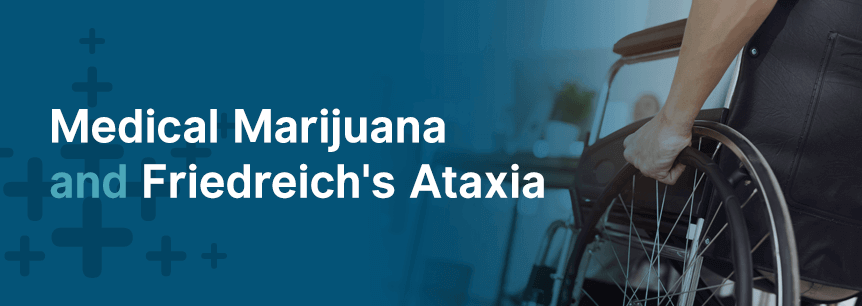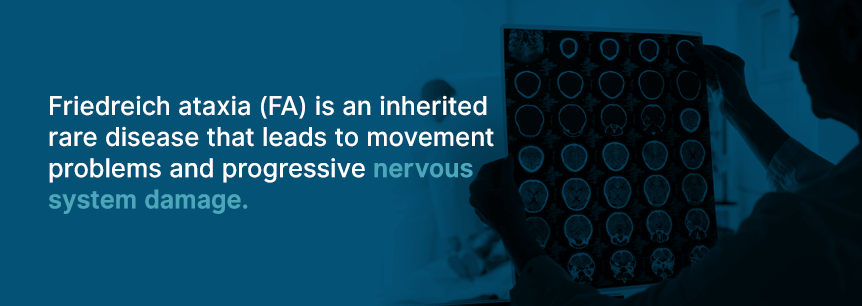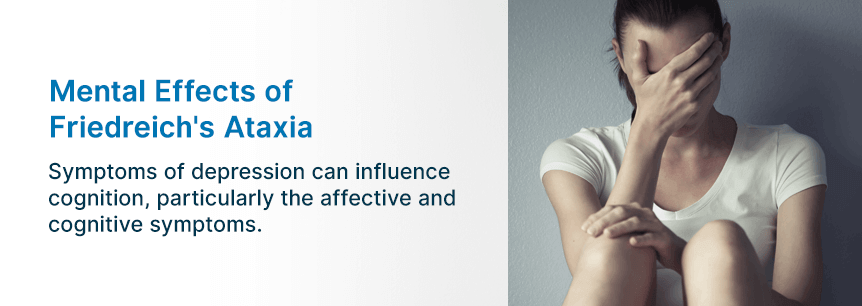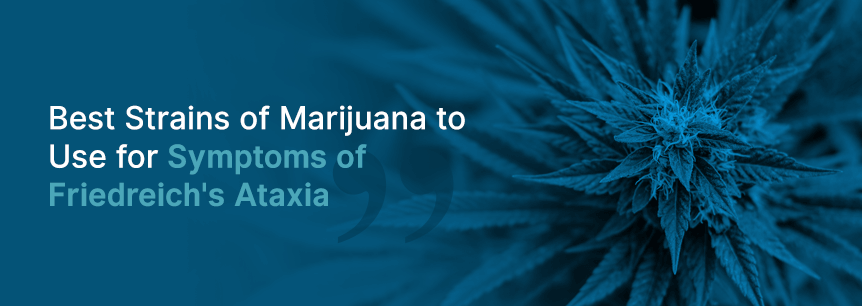
Symptoms of Friedreich’s ataxia can seriously affect your daily life. Whether it’s pain, inflammation, muscle spasms or insomnia, you need something useful to address your symptoms so you can improve the quality of your life and get on with it. Fortunately, medical marijuana and Friedreich’s ataxia treatment could be your answer.
Friedreich ataxia (FA) is an inherited rare disease that leads to movement problems and progressive nervous system damage. Many people develop it in their childhood, and it results in ataxia, which is impaired coordination of the muscles that becomes worse over time.

In FA, peripheral nerves and spinal cord nerve fibers degenerate and become thinner. Your peripheral nerves carry information to your body and then back to your brain. For instance, they may send a signal to your muscles to produce movement or a message to your brain that your feet are cold. The cerebellum, or the part of your brain that coordinates movement and balance, also degenerates to a smaller degree.
This damage leads to impaired sensory functions and unsteady, awkward movements. FA can also cause heart and spine problems as well as diabetes in some individuals. It doesn’t affect your cognitive functions or thinking.
FA results from a mutation in a gene labeled FXN that carries the frataxin protein’s genetic code. People who inherit two mutated copies of the gene — one from their mother and one from their father — will develop FA. While it is rare, it’s the most common type of hereditary ataxia in the U.S. and affects around one in every 50,000 individuals, according to the National Institute of Neurological Disorders and Stroke (NINDS). Both female and male kids can also inherit the condition.
How fast it progresses varies between people. Typically, a patient gets confined to a wheelchair within 10 to 20 years of experiencing their first symptoms of the disorder. In later stages of FA, individuals can become incapacitated. FA can shorten your life expectancy, with the most common cause of fatality being heart disease. There are people, however, with less severe FA symptoms who live past 60 years old or older.
Doctors can diagnose Friedreich’s ataxia between the ages of 2 through the early 50s, but those between 10 to 15 years old are the most common age group to receive a diagnosis. Difficulty walking is the most common first symptom of the disease. Other symptoms may include:
Many patients with this disease also suffer from heart disease. In fact, around 75 percent of FA patients have heart abnormalities. Hypertrophic cardiomyopathy is the most common type and is a thickening of your heart muscle.
Heart disease symptoms include:
FA can eventually cause diabetes.
FXN gene mutations cause Friedreich ataxia. As mentioned, the FXN gene delivers instructions to make the frataxin protein. While doctors and researchers don’t fully understand the role of frataxin, it’s essential for the regular function of mitochondria, or the centers that produce energy within cells.
One FXN gene region contains a part of DNA referred to as a GAA trinucleotide repeat, which is a few DNA building blocks that show up multiple times in a row. Usually, this GAA segment repeats five to 33 times within your FXN gene, reports the U.S. Department of Health and Human Services.
Those with FA have a GAA segment that repeats between 66 to more than 1,000 times. The severity of your symptoms, how quickly they progress and the age at which you first experienced them usually influences the GAA trinucleotide repeat length.
Those who have GAA segments that repeat fewer than 300 times seem to experience their symptoms at a later age — more than 25 years older than those who have larger GAA segment repeats. Irregularly long GAA repeats disrupt frataxin production, seriously reducing the amount of frataxin in cells. Certain muscle and nerve cells can’t properly function when there’s a frataxin shortage, and this leads to the characteristic symptoms of FA.
Some patients experience complications of Friedreich’s ataxia, including:
Doctors and researchers have long recognized cardiac involvement in FA. In 1863, five of six FA cases had heart abnormalities. These days, identification of a primary myocardial disease familial type in individuals with no ataxia has revived interest in FA disease myocardial changes.
Both cognitive-affective and somatic-motivational symptoms of depression frequently occur in people with FA, according to data published in the International Journal of Clinical and Health Psychology. Additionally, symptoms of depression can influence cognition, particularly the affective and cognitive symptoms.

FA patients should address certain symptoms through counseling and medication, including:
Facts about Friedreich’s ataxia, according to the U.S. Department of Human Health & Services, include:
In 1863, Nikolaus Friedreich, a German physician, first described Friedreich’s ataxia as a neuromuscular disease primarily impacting the heart and nervous system.
Identification of frataxin gene mutations in the 1990s as the underlying reason for FA provided a far better understanding of the disease for the development of treatment.

Friedreich’s ataxia treatment is supportive and symptomatic. The best approach is a multidisciplinary treatment strategy, provided the disease impacts multiple organ systems. Ongoing medical monitoring will help avoid possible complications that involve the:
To help sustain an active lifestyle, the doctor may prescribe things like:
Non-surgical interventions or orthopedic surgery might help feet abnormalities and spinal curvature. However, this is something you should discuss during consultation with your orthopedic surgeon and neurologist.
FA-associated diabetes mellitus and heart problems may require medication. Your doctor may prescribe anti-cardiac failure medicine and anti-arrhythmic agents to treat heart disease.
Medication for heart problems can cause certain side effects, including:
The doctor might prescribe oral hypoglycemic therapeutics, dietary modification or insulin to control diabetes mellitus. Insulin does come with side effects, with the major ones being:
If you’re inhaling insulin and you have chronic obstructive pulmonary disease or asthma, there’s the risk of your lungs suddenly tightening.
The doctor can correct hearing and vision problems with medications and corrective devices. Your intelligence stays intact. Psychological counseling can help with emotional strain for both you and your family, and speech therapy can help maximize your verbal communication skills.
NIH-funded research on FA includes identifying the cause of the gene mutation and its functioning, gaining more knowledge and understanding of the protein frataxin, exploring ways of overriding the genetic mutation and developing better treatments for FA.
NINDS and a few other centers and institutes of the NIH support FA research. Among current projects funded by the NINDS, researchers are hopeful they can start defining the process of silencing the FXN gene, which could open up possible ways of restoring normal gene function.
Other researchers funded by the NINDS are working on developing new FA animal models that act quite similar to the gene mutations found in humans with the condition. Researchers require both existing models and these new models as essential research tools for defining the disease’s cellular defects in more detail and enhancing novel therapy search.
Researchers have completed, are carrying out or are recruiting for clinical trials for Friedreich’s ataxia to further the understanding and treatment success of the condition.
Research has already shown medical marijuana has neuroprotective properties. The herb reduces inflammation and assists in regenerating brain cells, potentially benefiting ataxia patients, particularly in slowing the disease’s progression down.
Cannabinoids suppress glial activation, excitotoxicity and oxidative injury that lead to neuron degeneration, according to authors reporting in CNS & Neurological Disorders. Cannabinoids improve the mitochondria function in cells and improve cellular debris clearance activation — further promoting neuron health.
Marijuana for Friedreich’s ataxia can help with symptoms of FA, including:
Many individuals use medical marijuana for Friedreich’s ataxia to relieve muscle spasticity. In one survey in 1982 of individuals with spinal cord injuries, reports of cannabis reducing muscle spasticity came from 21 of the 43 survey respondents.
Distinct compounds in marijuana and Friedreich’s ataxia treatment affect the human body differently. For instance, tetrahydrocannabinol helps relieve nausea and pain, acts as an antioxidant and reduces inflammation, according to the American Cancer Society.
A 2013 study of healthy people who use cannabis published in the American Journal of Addiction found they didn’t have as much trouble falling asleep as before, it didn’t take as long for them to fall asleep and the following day, they had more daytime sleep.
Living with the disease can lead to depression because FA’s symptoms inhibit an individual’s ability to live their life completely and to the fullest extent. Rather than taking antidepressants, they can now use medical pot to relax, gain a sense of optimism and feel happy. While cannabis does have some side effects like memory loss, increased appetite, poor decisions and paranoia, the side effects of antidepressants can be much worse.
And, increased appetite isn’t a bad thing for ataxia patients, since some may find it hard to eat and swallow, preventing them from getting the essential nutrients their bodies need to strengthen their immune system and slow the disease’s progression down.

Certain medical marijuana and Friedreich’s ataxia strains can tackle many of the symptoms of the illness. These strains include:
Your cannabis dispensary budtender can help you select a strain or strains that can help your specific Friedreich’s Ataxia symptoms.
Marijuana for Friedreich’s ataxia varies in application and treatment. You can smoke it, eat it or apply it on your skin, depending on your symptoms and strain you’re using.
For instance, topicals like cannabis-infused lotions, creams and salves are good for muscle cramps and spasms. The solution numbs the localized area, muting the pain and easing the muscle out of the spasm.
Try CBD oil in a mouth spray to decrease muscle spasms and spasticity, as well as pain and sleep disturbances. While a mouth spray of CBD oil is popular, you can also relieve your pain and other symptoms with a CBD inhaler.
These are just some practical ways of using your treatment to ease your symptoms. You may also use other methods such as:
While smoking may have been a popular choice in the past, there are many other methods to consume cannabis today without having the potential respiratory side effects when you smoke marijuana. Talk with your cannabis doctor about the method that will best help you and your symptoms.
Although you can find a lot of information about medical marijuana on the Internet, it’s better if you speak to a professional, qualified medical cannabis doctor. They’ll be able to answer all your questions, come up with a treatment plan and point you in the right direction of which cannabis products you may want to use.

Be sure to check with your state first to ensure medical cannabis is legal there, as some states are still pending legalization. However, many states continue to qualify conditions for medical marijuana.
Once you’ve gained knowledge on your state laws regarding whether you qualify for marijuana and Friedreich’s ataxia treatment, you can then book an appointment on MarijuanaDoctors.com to consult with a licensed cannabis doctor to begin your first steps into starting medical cannabis treatment.
Find A Doctor Find A Dispensary